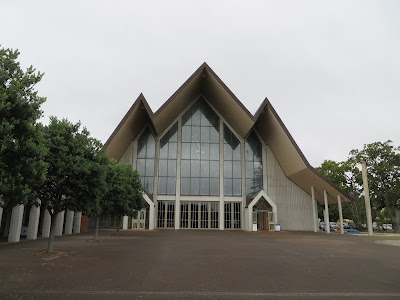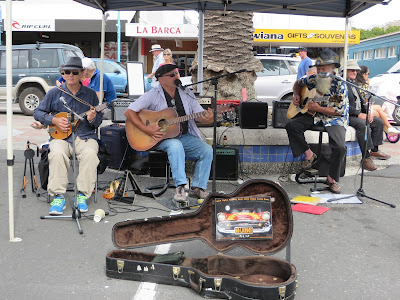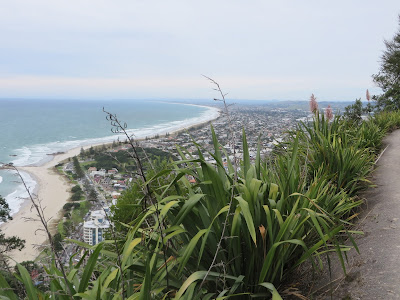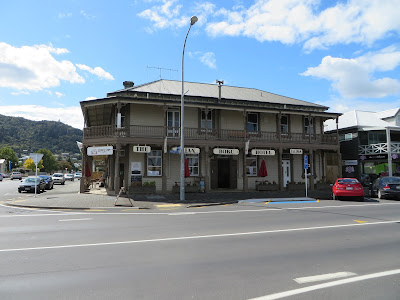Next Stop - Aussie Gold Coast
After a fantastic month on the North Island of New Zealand, the next stop was the Gold Coast of Australia. More specifically, the town of Lennox Head, where my long-time friend Jim lives. When I say long-time friend, I mean it. Our friendship started in the fall of 1972 when we started graduate studies at the University of Waterloo (Canada). A friendship of almost 43 years is quite rare and, thanks to email we've had more regular contact in the past decade or so than in the years immediately after finishing grad school and going off to establish careers. We have connected in person a few times over the years with the most previous being in England in 2007 when I visited him in Durham where he was faculty at Durham University. This was my first time to visit him in Australia and, in fact, my first time in that country.
As was the case in grad school, our conversations quickly got into spirited discussions about a wide range of topics - politics, education, race, justice, travel, families, etc. Other than catching up on some details of life, it was like our conversations picked up where they were last left. Our conversations evoked memories of similar discussions from years past when we were usually joined by one or more friends at the on-campus grad house or at the townhouse we rented with another friend. It didn't take long to once again engage in more substantive conversation. Mind you, there were many times that stories from the past surfaced to provide much laughter - some things that had been forgotten and other things I sort of wish I couldn't remember.
Lennox Head is a seaside town of about 10,000 in New South Wales located between Byron Bay and the local government town of Ballina. The town of Lennox Head has grown in recent years and continues to be a very popular destination with surfers, beach fans and others. There is a headland with a 65 metre cliff that is popular with hang gliders. Dolphins and whales are another frequent attraction. Geologically, there is a large amount of basaltic lava spread across the area, which can present significant danger for surfers not familiar with the local currents.
It takes three hours for a direct flight from Auckland to Coolangatta (main international airport for Lennox Head). The flight was fine and it didn't take too long to get into the arrivals area to connect with Jim. Like any new place, I am immediately draw to what was there, so the drive to his house with a couple of stops was a great orientation to a beautiful part of the world. Except for walking on a beach, I am not much into swimming or working on my tan, but I very much appreciate the beauty of the wide and long sandy beaches and seemingly endless sky. The environment invites relaxation and I can understand why Jim moved to Lennox Head.
On the first evening, we went out for dinner at Foam. http://www.foamlennox.com/. It was a fantastic evening and everything was perfect - food, wine, service, location overlooking the beach and conversation. The people who own Foam and their staff are top notch in every sense - friendly, knowledgeable and helpful. We went there again for dinner and also stopped a number of time for a morning coffee and a light breakfast. The food quality and the recommended wine pairings were exceptional. While the place has lots of class, it is not at all pretentious. Completely enjoyed these experiences!
Johnny Cash Revisited
One of the highlights of day two was going to a Johnny Cash concert performed by an Aussie named Daniel Thompson. He is a fine performer and did a great job of providing the authentic sound and style of Cash. I've been a fan of Cash for a long time, so this was a very good choice.
After the Cash event, we headed off to meet some of Jim's friends for dinner. The attention of many people at the pub style restaurant was on the final match of the cricket world cup (Australia vs. New Zealand). The Aussie crowd was pleased to see their country be victorious. While I watched some of these games in New Zealand, I can honestly say that it is a sport that so far has eluded me in terms of understanding it. When it comes to describing cricket, I think this quote from Bill Bryson in his book "In a Sunburned Country" nicely summarizes my sentiments: "It is not true that the English invented cricket as a way of making all other human endeavors look interesting and lively; that was merely an unintended side effect. ...It is the only sport that incorporates meal breaks. It is the only sport that shares its name with an insect. It is the only sport in which spectators burn as many calories as the players-more if they are moderately restless."
Byron Bay
One of the most popular destinations on the Gold Coast is Byron Bay, where the surf and beaches are big attractions. I think I'd describe the town as quaint in some respects, but it just seems to be too popular which, of course, means it is crowded with more than enough traffic. Finding a parking spot is about as rare as a surfer catching the "big wave." First thing in Byron Bay was when Jim dropped me at the foot of the hill on which the famous Byron Bay lighthouse is located. I walked to the top and enjoyed the scenery all the way. While there were lots of other folks out for a walk up to the lighthouse, it was not crowded and it was nice to get out and get a bit of exercise and fresh air after a few days that were quite sedentary.
An unexpected surprise near the top was seeing a wallaby munching away on grass. Near the same spot, I was told by another hiker that there was a pod of dolphins off shore a bit, but I could barely see evidence of this and unfortunately my camera wasn't able to zoom in on the pod. This is the most easterly point in Australia and a nice complement to having visited Gisborne, NZ, which is the first place the sun rises due to its proximity to the international dateline.
Out and About
Over the next few days, we explored the countryside and areas near Lennox Head - fun and interesting. We drove through rural areas where macadamias, avocados, coffee and sugar cane are grown. Of the crops for commercial purposes, I was surprised that so much coffee was grown in this area. I had never thought of Australia as being a country known for its coffee production, but some of the best coffee I've ever had was there and also in New Zealand. Another travel discovery!
On one drive, we stopped adjacent to a small school with a pottery shop (Red Door Studio) across the road. We engaged the teacher in conversation (I think she was just checking us out to ensure we were there for legitimate reasons). Once we introduced ourselves and why we stopped, she was very engaging and we learned that the school had only 24 students with what seemed like a great community-based approach to education. We came across quite a few of these small schools when driving in the countryside. We next checked out the pottery studio and had another great conversation with the owner - a talented and and spunky potter named Brooke Clunie. Check her website http://www.brookeclunie.com/. These are the kind of experiences that make exploration and travel so fascinating.
In just a few days, it was great to meet so many welcoming and warm local people. In Lennox Head, I was already getting to know some folks in a couple of cafes and restaurants!
One day, we took a bit of a further drive to the colourful hippie town of Nimbin!!! A truly unique place where people wear tie-dyed clothing that also can be purchased in many shops. There are many backpacker hostels, dreadlocked locals and visitors, and a whole lot more. Within a minute of getting out of the car, a young man walked past me just a couple of feet away and asked if I wanted to "buy some weed." I respectfully declined the offer. Jim was reading a poster on a store window and didn't even see what happened - good for a few laughs.
On another note, Nimbin is known for local environmental and sustainability initiatives as well as having a cannabis counterculture. The town has multi-colured benches and a street called Alternative Way - a most suitable street name. It is also the home of the Nimbin Hemp Embassy. Nimbin is a truly iconic town and well worth a visit if you're in the area. People wanting to "drop out" are drawn to the town, including non-Aussies. Interests in new development projects have been strongly resisted by locals.
A big highlight was going to the World
Heritage Nightcap National Park for a walk through rain forest to
Protesters Falls. The falls acquired its name from citizen protests in the Terania Creek area in
the late 1970s that saved the pristine forest and protected threatened species from
being decimated by logging. The efforts of the protestors have left a very important habitat protected for wildlife and humans to enjoy. After walking about 15 minutes through steamy, dipping forest you arrive at the foot of a 30 metre high falls. While not especially high, it seems dramatic because of its closeness. The rain forest has a variety of large trees on the scale of what we have on coastal BC, but of different species of course. We only saw three other people at the beginning of the walk and then the only thing we could hear was the waterfalls and birds. Idyllic! The park is only about
an hour away from the sandy beaches and warm water off Lennox Head.
While we experienced a couple of days with quite a few rain showers and overcast sky, the sun shone on my last full day on the Gold Coast. Despite the weather, we got out to see the countryside on another trip - this time to Minyon Falls. The falls are 100 metres high and located in a lush, heavily forested area. We stopped first at a viewing platform across from the falls that provided an excellent view of the size of the falls and the setting. Then we drove to another viewing platform located beside where the river drops off at the top of the falls for a close view. Another subtropical rain forest - so much beauty there.
So long for now.....
A great time in Lennox Head and area! As I reflect on hanging out with my long-time friend, here's an appropriate quote.
"Life may scatter and keep us apart; it may prevent us from thinking very often of one another; but we know that our comrades are somewhere 'out there' - where, one can hardly say - silent, forgotten, but deeply faithful. And when our path crosses theirs, they greet us with such magnificent joy, shake us so gaily by the shoulders! Indeed we are accustomed to waiting." - Antoine Saint Exupery
After a fantastic month on the North Island of New Zealand, the next stop was the Gold Coast of Australia. More specifically, the town of Lennox Head, where my long-time friend Jim lives. When I say long-time friend, I mean it. Our friendship started in the fall of 1972 when we started graduate studies at the University of Waterloo (Canada). A friendship of almost 43 years is quite rare and, thanks to email we've had more regular contact in the past decade or so than in the years immediately after finishing grad school and going off to establish careers. We have connected in person a few times over the years with the most previous being in England in 2007 when I visited him in Durham where he was faculty at Durham University. This was my first time to visit him in Australia and, in fact, my first time in that country.
As was the case in grad school, our conversations quickly got into spirited discussions about a wide range of topics - politics, education, race, justice, travel, families, etc. Other than catching up on some details of life, it was like our conversations picked up where they were last left. Our conversations evoked memories of similar discussions from years past when we were usually joined by one or more friends at the on-campus grad house or at the townhouse we rented with another friend. It didn't take long to once again engage in more substantive conversation. Mind you, there were many times that stories from the past surfaced to provide much laughter - some things that had been forgotten and other things I sort of wish I couldn't remember.
Lennox Head is a seaside town of about 10,000 in New South Wales located between Byron Bay and the local government town of Ballina. The town of Lennox Head has grown in recent years and continues to be a very popular destination with surfers, beach fans and others. There is a headland with a 65 metre cliff that is popular with hang gliders. Dolphins and whales are another frequent attraction. Geologically, there is a large amount of basaltic lava spread across the area, which can present significant danger for surfers not familiar with the local currents.
On the first evening, we went out for dinner at Foam. http://www.foamlennox.com/. It was a fantastic evening and everything was perfect - food, wine, service, location overlooking the beach and conversation. The people who own Foam and their staff are top notch in every sense - friendly, knowledgeable and helpful. We went there again for dinner and also stopped a number of time for a morning coffee and a light breakfast. The food quality and the recommended wine pairings were exceptional. While the place has lots of class, it is not at all pretentious. Completely enjoyed these experiences!
Johnny Cash Revisited
One of the highlights of day two was going to a Johnny Cash concert performed by an Aussie named Daniel Thompson. He is a fine performer and did a great job of providing the authentic sound and style of Cash. I've been a fan of Cash for a long time, so this was a very good choice.
After the Cash event, we headed off to meet some of Jim's friends for dinner. The attention of many people at the pub style restaurant was on the final match of the cricket world cup (Australia vs. New Zealand). The Aussie crowd was pleased to see their country be victorious. While I watched some of these games in New Zealand, I can honestly say that it is a sport that so far has eluded me in terms of understanding it. When it comes to describing cricket, I think this quote from Bill Bryson in his book "In a Sunburned Country" nicely summarizes my sentiments: "It is not true that the English invented cricket as a way of making all other human endeavors look interesting and lively; that was merely an unintended side effect. ...It is the only sport that incorporates meal breaks. It is the only sport that shares its name with an insect. It is the only sport in which spectators burn as many calories as the players-more if they are moderately restless."
Byron Bay
One of the most popular destinations on the Gold Coast is Byron Bay, where the surf and beaches are big attractions. I think I'd describe the town as quaint in some respects, but it just seems to be too popular which, of course, means it is crowded with more than enough traffic. Finding a parking spot is about as rare as a surfer catching the "big wave." First thing in Byron Bay was when Jim dropped me at the foot of the hill on which the famous Byron Bay lighthouse is located. I walked to the top and enjoyed the scenery all the way. While there were lots of other folks out for a walk up to the lighthouse, it was not crowded and it was nice to get out and get a bit of exercise and fresh air after a few days that were quite sedentary.
An unexpected surprise near the top was seeing a wallaby munching away on grass. Near the same spot, I was told by another hiker that there was a pod of dolphins off shore a bit, but I could barely see evidence of this and unfortunately my camera wasn't able to zoom in on the pod. This is the most easterly point in Australia and a nice complement to having visited Gisborne, NZ, which is the first place the sun rises due to its proximity to the international dateline.
Over the next few days, we explored the countryside and areas near Lennox Head - fun and interesting. We drove through rural areas where macadamias, avocados, coffee and sugar cane are grown. Of the crops for commercial purposes, I was surprised that so much coffee was grown in this area. I had never thought of Australia as being a country known for its coffee production, but some of the best coffee I've ever had was there and also in New Zealand. Another travel discovery!
In just a few days, it was great to meet so many welcoming and warm local people. In Lennox Head, I was already getting to know some folks in a couple of cafes and restaurants!
One day, we took a bit of a further drive to the colourful hippie town of Nimbin!!! A truly unique place where people wear tie-dyed clothing that also can be purchased in many shops. There are many backpacker hostels, dreadlocked locals and visitors, and a whole lot more. Within a minute of getting out of the car, a young man walked past me just a couple of feet away and asked if I wanted to "buy some weed." I respectfully declined the offer. Jim was reading a poster on a store window and didn't even see what happened - good for a few laughs.
On another note, Nimbin is known for local environmental and sustainability initiatives as well as having a cannabis counterculture. The town has multi-colured benches and a street called Alternative Way - a most suitable street name. It is also the home of the Nimbin Hemp Embassy. Nimbin is a truly iconic town and well worth a visit if you're in the area. People wanting to "drop out" are drawn to the town, including non-Aussies. Interests in new development projects have been strongly resisted by locals.
While we experienced a couple of days with quite a few rain showers and overcast sky, the sun shone on my last full day on the Gold Coast. Despite the weather, we got out to see the countryside on another trip - this time to Minyon Falls. The falls are 100 metres high and located in a lush, heavily forested area. We stopped first at a viewing platform across from the falls that provided an excellent view of the size of the falls and the setting. Then we drove to another viewing platform located beside where the river drops off at the top of the falls for a close view. Another subtropical rain forest - so much beauty there.
So long for now.....
A great time in Lennox Head and area! As I reflect on hanging out with my long-time friend, here's an appropriate quote.
"Life may scatter and keep us apart; it may prevent us from thinking very often of one another; but we know that our comrades are somewhere 'out there' - where, one can hardly say - silent, forgotten, but deeply faithful. And when our path crosses theirs, they greet us with such magnificent joy, shake us so gaily by the shoulders! Indeed we are accustomed to waiting." - Antoine Saint Exupery





































































































